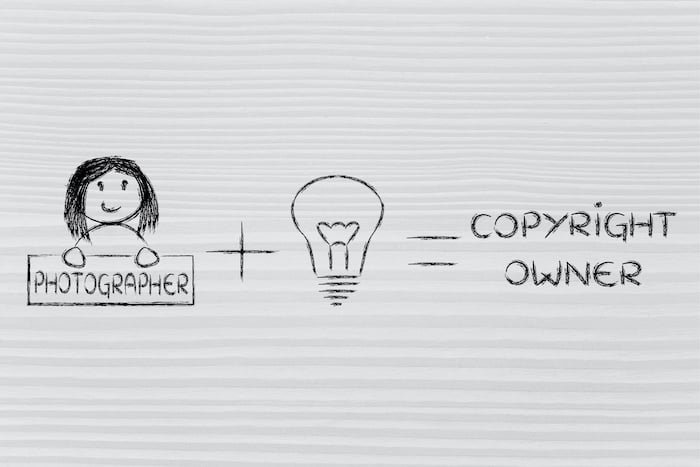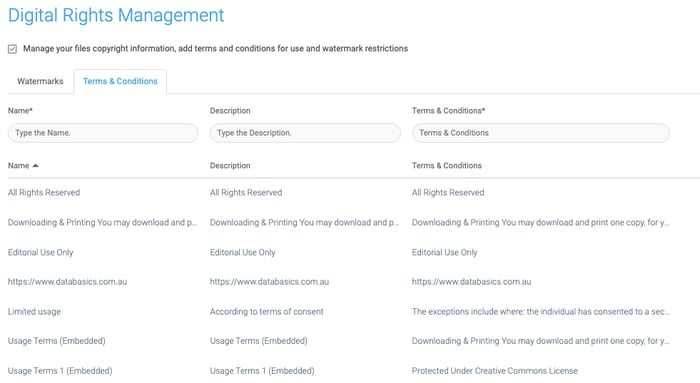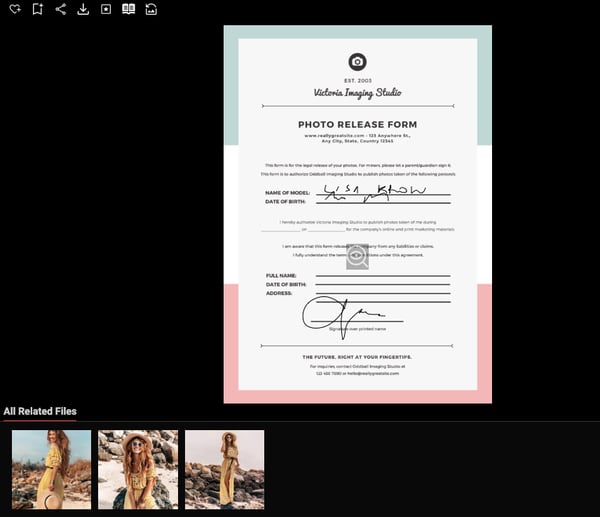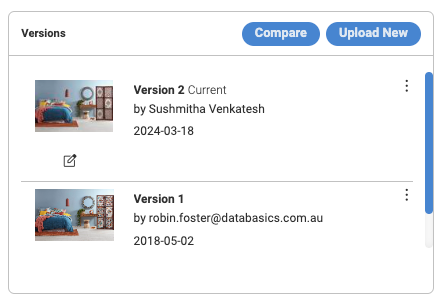Understanding Copyright for Images
April 16, 2024 •Sushmitha Venkatesh

This article explores the intricacies of Australian copyright laws and regulations related to images, and how to effectively manage copyrights in a digital asset management solution.
Understanding Copyright Laws for Images
Copyright laws for images are designed to protect the rights of the creators and owners of visual content. These laws grant exclusive rights to the copyright holders, allowing them to control how their images are used, reproduced, distributed, and displayed.
In order for an image to be protected by copyright, it must meet the requirements of originality and fixation. Originality means that the image is the result of the author's own intellectual creation, and fixation means that the image is recorded in a tangible form, such as a digital file or a print.
Copyright laws vary from country to country, but they generally provide the copyright holder with the exclusive right to reproduce the image, prepare derivative works based on the image, distribute copies of the image, and display the image publicly. These rights can be licensed or transferred to others, allowing them to use the image in specific ways.
Under Australian copyright law, copyright protection automatically applies to original works as soon as they are created and fixed in a tangible form, such as writing, recording, or saving to a digital file. These rights are outlined in the Copyright Act 1968 (Cth), which governs copyright law in Australia.
It is important for individuals and businesses to understand copyright laws for images in order to avoid legal issues and ensure compliance with the regulations. This includes obtaining appropriate licenses or permissions for using copyrighted images and respecting the rights of the copyright holders.
The Importance of Copyright Management
Copyright management is crucial in order to protect the rights of image creators and owners, as well as to avoid legal consequences. Effective copyright management allows individuals and businesses to control the use and distribution of their copyrighted images, ensuring that they are used in accordance with the applicable laws and regulations.
By implementing proper copyright management practices, organisations can prevent unauthorised use of their images, protect their intellectual property, and maintain their reputation. It also enables them to monetise their copyrighted images by licensing them for commercial use.
Copyright management involves various processes, such as acquiring licenses for using copyrighted images, tracking and monitoring image usage, enforcing copyright infringement claims, and educating employees and stakeholders about copyright laws and best practices.
Overall, copyright management plays a crucial role in safeguarding the rights of image creators and owners, promoting fair use of copyrighted images, and maintaining a compliant and ethical approach to image usage.
Key Aspects of Copyright Management
Exclusive Rights:
Copyright grants creator’s exclusive rights to their original works, including the rights to reproduce, distribute, perform, display, and create derivative works based on the original.
Automatic Protection:
Copyright protection arises automatically upon the creation and fixation of an original work in a tangible form. Registration is not required for copyright to exist, though it may provide additional legal benefits.
Duration:
Copyright protection is limited in duration. The duration varies depending on factors such as the type of work, the jurisdiction, and when it was created or published. Typically, copyright lasts for the life of the author plus a certain number of years after their death.
Public Domain:
Once copyright protection expires, the work enters the public domain, where it can be freely used, reproduced, distributed, or modified by anyone without permission or payment.
Fair Use:
Many jurisdictions have exceptions or limitations to copyright known as fair use (in the United States) or fair dealing (in other countries). These provisions allow for the limited use of copyrighted material for purposes such as criticism, commentary, news reporting, teaching, scholarship, or research, without the need for permission from or payment to the copyright holder.
But Who Owns Copyright?
Copyright ownership can vary depending on the jurisdiction and the specific circumstances surrounding the creation of the work. Additionally:
Individual Creators
For works created by individual authors, the copyright belongs to the person who created the work. This includes writers, artists, musicians, photographers, programmers, and other creators.
Joint Ownership
In some cases, multiple individuals may contribute to the creation of a work. In these situations, copyright may be jointly owned by the creators, unless there is an agreement stating otherwise.
Employer-Employee Relationship
When an employee creates a work within the scope of their employment, the employer is usually considered the copyright owner, unless there is an agreement stating otherwise.
Commissioned Works
If a work is created under a contract or commission, the terms of the contract will determine copyright ownership. In some cases, the creator retains copyright, while in others, the commissioning party may own the copyright.
Freelancers and Contractors
In many jurisdictions, freelancers and independent contractors retain copyright ownership of the works they create, unless there is a contract or agreement stating otherwise.
Optimising Copyright Management in Digital Asset Management
Digital Asset Management (DAM) solutions provide a centralised platform for organising, storing, and distributing digital assets, including images. Optimising copyright management within a DAM solution offers several benefits for individuals and businesses.
Firstly, it allows for efficient organisation and categorisation of images, making it easier to track and manage copyright information associated with each image. This includes metadata such as copyright notices, usage rights, and licensing information.
Secondly, a DAM solution can automate the process of acquiring licenses for copyrighted images, streamlining the workflow and ensuring compliance with copyright laws. It can also provide notifications and reminders for license renewals or expirations.
Furthermore, a DAM solution can enable granular access control, allowing administrators to restrict access to copyrighted images based on user roles and permissions. This helps prevent unauthorised use or distribution of copyrighted content.
By integrating copyright management features into a DAM solution, organisations can enhance their overall digital asset management practices, reduce the risk of copyright infringement, and improve the efficiency of their image-related workflows.
How to manage Copyrights in DAM? Amid rising copyright concerns, some key actions to consider
Rights Management:
Implement rights management features in the DAM system to enforce usage restrictions and permissions for copyrighted assets. This may include setting access controls, usage rights, and expiration dates for assets based on copyright agreements.

Relating files:
Relate image/ model release forms and other copyright documents to the respective images for easy access and reference.

Version Control:
Maintain version control of assets within the DAM system to track changes to copyright-related metadata over time. This ensures that the most up-to-date copyright information is always available and can be easily referenced when needed.

Regular Audits:
Conduct regular audits of copyright-related metadata and usage rights within the DAM system to ensure compliance with copyright laws and agreements. This helps identify any potential copyright issues or violations that need to be addressed.
Common Pitfalls in Copyrights Management
Managing copyrights can be a complex and challenging task, and there are several common pitfalls that individuals and businesses should be aware of.
One common pitfall is using images without obtaining the necessary licenses or permissions. This can lead to copyright infringement and legal consequences. It is important to always verify the copyright status of an image and obtain proper authorisation before using it.
Another pitfall is misunderstanding or misinterpreting the terms and conditions of image licenses. It is crucial to carefully read and understand the licensing agreements, including any restrictions or limitations on image usage, to avoid unintentional copyright violations.
Failure to properly attribute the source or author of an image is also a common pitfall. Giving credit to the original creator of an image is not only a matter of ethical practice, but it may also be a legal requirement depending on the specific license or copyright terms.
Additionally, inadequate record-keeping and documentation of image usage can pose challenges in copyright management. It is important to maintain accurate records of licenses, permissions, and usage history to demonstrate compliance and resolve any potential disputes.
By being aware of these common pitfalls and implementing proper copyright management practices, individuals and businesses can mitigate the risks associated with copyright infringement and ensure legal and ethical use of copyrighted images.
Preventing Copyright Infringement in a DAM Solution
Preventing copyright infringement in a DAM solution requires a proactive and comprehensive approach to copyright management.
Firstly, it is important to implement robust digital rights management (DRM) measures within the DAM solution. This includes features such as watermarks, access controls, and encryption to prevent unauthorised use or distribution of copyrighted images.
Secondly, regular audits and monitoring of image usage within the DAM solution can help detect any potential copyright infringements. This involves tracking and analysing image access logs, usage patterns, and user activities to identify any suspicious or unauthorised usage.
Educating employees and users about copyright laws, licensing requirements, and best practices is also essential in preventing copyright infringement. This can be done through training programs, guidelines, and policies that promote a culture of copyright compliance.
Furthermore, establishing clear guidelines and procedures for acquiring and managing licenses for copyrighted images within the DAM solution can help ensure that all image usage is legal and authorised.
By taking these preventive measures, organisations can significantly reduce the risk of copyright infringement in their DAM solution, protect their intellectual property, and maintain a compliant and ethical approach to image management.
STOP! THINK? Moral rights?
Right of Attribution (Paternity Right):
This right grants the creator the authority to claim authorship of their work and to be identified as such whenever the work is published, displayed, or distributed to the public. It ensures that creators receive proper credit for their creations.
Right of Integrity:
The right of integrity protects the creator's reputation and prevents any modifications, alterations, or distortions of their work that could be prejudicial to their honour or reputation. This includes actions such as mutilation, distortion, or destruction of the work.
These moral rights are often considered inherent to the creator and cannot be transferred or assigned to others. They are independent of the economic rights associated with copyright, meaning that even if an author assigns or licenses the economic rights to their work, they still retain their moral rights.
Copyright Fundamentals as applied to your DAM and how databasics can help you
Certainly! In Digital Asset Management systems, understanding copyright fundamentals not only helps you to manage its assets responsibly but also assists customers in navigating legal and ethical considerations.
Clear Usage Guidelines:
By incorporating copyright information into DAM systems, our databasics can provide clear usage guidelines to you. This helps you all to understand how they can legally and ethically use the assets they access through the DAM system, reducing the risk of unintentional copyright infringement.
Accessible Copyright Information:
Systems can make copyright information easily accessible by embedding metadata within assets or providing clear documentation alongside them. So you can quickly ascertain the copyright status of assets and determine what uses are permitted.
Legal protection and Enhanced customer trust:
Ensuring that assets available are properly licensed and copyright compliant protects you from potential legal liabilities and by prioritising copyright compliance and transparency in your DAM systems, databasics tend to build trust with everyone wherein they are more likely to engage you’re your organisations that demonstrate a commitment to respecting intellectual property rights and supporting ethical asset usage.


